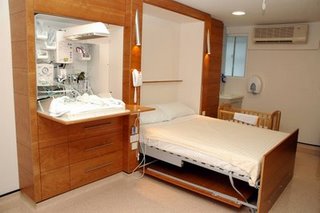Double bed
A large double bed is provided for the comfort of the childbearing woman. In labour she may choose to rest for periods in the bed however, an upright position has been found to reduce discomfort and also to shorten the duration of second stage of labour. Women choosing an upright position have been found to have shorter less painful labours and are less likely to require pain relief such as epidural anaesthetic. Babies born when the mother is in an upright position are more likely to establish spontaneous breathing at birth. It is more likely that women will choose an upright position with encouragement from the midwife and if the environment is arranged to support this. The room should be arranged with suitable places to for the woman to lean, mats to kneel on and the bed positioned so that it is not main focal point of the room. The labouring woman should be encouraged to be in a position which is comfortable for her.
Gupta JK, Hofmeyr GJ, Smyth RMD. Position in the second stage of labour for women without epidural anaesthesia. Cochrane Database of Systematic Reviews 2004, Issue 1. Art. No.: CD002006. DOI: 10.1002/14651858.CD002006.pub2.http://mrw.interscience.wiley.com/cochrane/clsysrev/articles/CD002006/frame.html
Luguna, H., Mlay, R., Smith, H. (2004).Mobility and maternal position during childbirth in Tanzania: an exploratory study at four government hospitals. BMC Pregnancy and Childbirth Online. Retrieved 24th March 2009 from http://www.biomedcentral.com/content/pdf/1471-2393-4-3.pdf
MIDIRS Informed Choice Pamphlet. (2007). Position in labour. Retrieved 24th March 2009 from http://www.verloskundigenwageningen.nl/folders%20engels/engelse%20folders/position%20in%20labour.pdf
Royal College of Midwives. (2008). Positions for labour and birth: Midwifery practice guideline. Retrieved 24th march 2009 from http://www.library.nhs.uk/womenshealth/viewResource.aspx?resID=82516 Media:Example.ogg
Block quote </blockquote>
